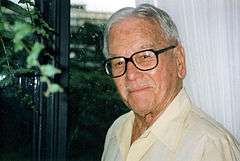Henry H. Carter

Henry Hare Carter (28 June 1905 - 2001) was an American linguistics professor, [1] commander in the US Naval Reserve, translator, and a Spanish or Portuguese writer of textbooks [2] and research.
Life and career
Henry Hare Carter was born on June 28, 1905, in Staten Island, New York, to John Hanford and Elizabeth Carter (née Ensminger). He married Gloria Maria Castello Branco de Gouveia (deceased May 16, 2015) in Recife, Brazil in 1946.
Professor Carter received his B.S., A.M. & Ph.D.[1] degrees from the University of Pennsylvania in years 1928, 1931 and 1937.[1] Dr. Carter was a professor of romance languages for almost 40 years at several colleges and universities, including the University of Pennsylvania; Northwestern University, Evanston; the Naval Academy; DePaul University; Colorado College; and for the last 24 years of teaching (from 1956) at the University of Notre Dame[1] in South Bend, Indiana, where he retired as Professor Emeritus of Romance Languages and Literatures.[1]
Among his teaching specialities were Spanish literature; the history of the Spanish language; and Spanish poetry, drama, and prose. He spoke seven languages.
During his student days, he would often travel and study abroad during the summers in Europe with foreign studies,[1] including Madrid in 1931, the Sorbonne (Paris) in 1933, Corsi Roma (Rome) 1937, and Coimbra, Portugal in 1939.[1]
For most of his professional life he was interested in the translation of 12th- and 13th-century manuscripts, written by monks, about the stories of Joseph of Arimathea and the Holy Grail, and the legend of El Cid. He also was a scout on his travels in South America and Spain for new Spanish words to be included in the Williams' Spanish-English Dictionary. His endorsement of the book was included on the front cover of the paperback edition.
Henry Carter was elected to numerous academies, both in the United States and abroad, including: the Brazilian Academy of Philology (1971),[1] the Academy of Sciences, Lisbon (1975),[1] and Académico de Mérito, in the Portuguese Academy of History (1989).[1]
During World War II, he was assigned to the Office of Naval Intelligence; serving in Washington, D.C., Puerto Rico, and Brazil, where he was the liaison officer between the American and Brazilian navies. He retired from the US Naval Reserve with the rank of commander. During his Navy years, he wrote Paleographical Edition and Study of the Language of a Portion of Codex Alcobacensis 200 and Cancioneiro da Ajuda: A Diplomatic Edition (1941).
In retirement, Professor Carter resided with the Congregation of Holy Cross at Moreau Seminary, where he regularly shared stories of the obscure origins of words and delighted generations of seminarians.
He died in 2001 and was survived by his daughter, Christina Elizabeth Daltro, living in Porto das Dunas, Aquiraz, Ceará, Brazil and in Ocean Springs, MS, and his son, Bruce Edward de Gouveia Carter (deceased November 2014), grandchildren Elithea Van Note, Leana Carter and Tony Carter, living in the US, and Claudia Daltro de Souza and Sylvia Daltro de Souza, both from São Paulo and Brasilia, Brazil; a great-grandson, Henry William Van Note, a great-granddaughter, Clara Evangeline Van Note, both of Moline, IL, a great-grandson Caian Daltro Salgado, Claudia's son, living in São Paulo, Brazil, and twin grandchildren Julia and Lucas Daltro Perreira, living in Brasília-DF, Brazil, Christina Elizabeth Carter Daltro's grandchildren.
Works
- Paleographical Edition and Study of the Language of a Portion of Codex Alcobacensis 200; Philadelphia: University of Pennsylvania, 1938.[3]
- Cancioneiro da Ajuda: A Diplomatic Edition; New York: Modern Language Association of America, 1941 (Dewey: 869.1).[4]
- Contos e anedotas brasileiros; A Graded Portuguese Reader, Boston: D. C. Heath and Co., 1942.
- The Portuguese book of Joseph of Arimathea—Paleographical edition with Introduction, Linguistic study, Notes, Plates & Glossary, (editor), North Carolina; Chapel Hill-University of North Carolina, 1967.
- Cuentos de España hoy (compiled by); Holt, Rinehart and Winston, 1974. ISBN 0-03-086042-3
Notes
- 1 2 3 4 5 6 7 8 9 10 "University Teaching Faculty" (Notre Dame list), Notre Dame University, 2006, webpage: ND-506FACI-PDF: states "Professor Emeritus of Romance Languages and Literatures" (plural), lists degrees/years from UPenn, at Notre Dame 1956.
- ↑ "Cancioneiro Da Ajuda: A Diplomatic Edition by Henry Carter," webpage: [www.textbookx.com/detail-book-0527147001.html TBookX-7147001].
- ↑ untitled review, Raymond S. Willis, Jr., Hispanic Review, July 1939, pp. 264-268, accessed May 29, 2007.
- ↑ untitled review, Raymond S. Willis, Jr., Hispanic Review, October 1942, pp. 350-352, accessed May 29, 2007.